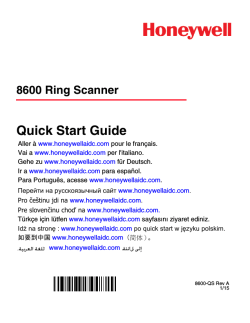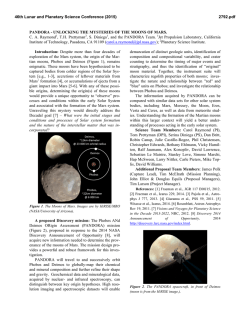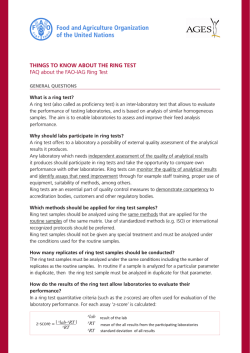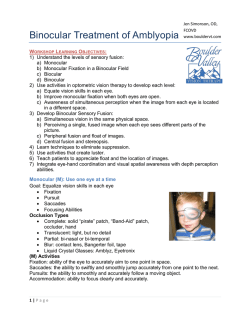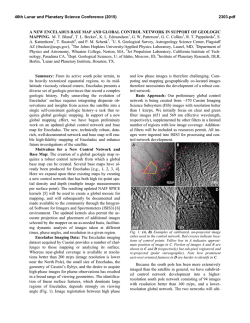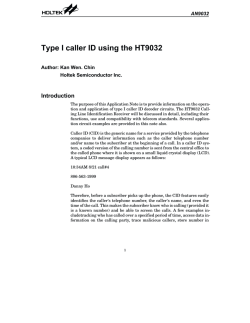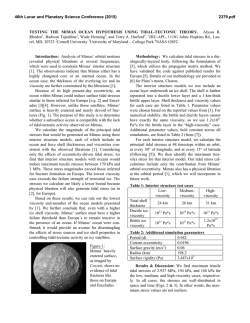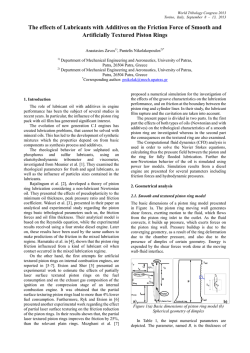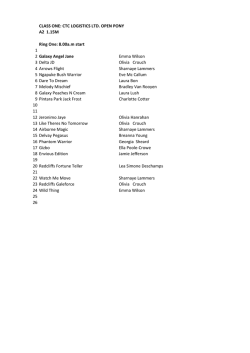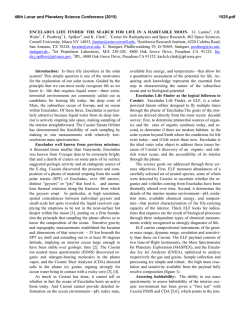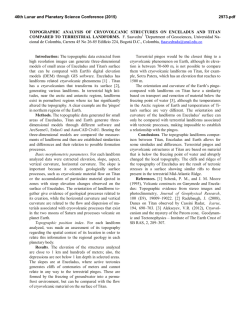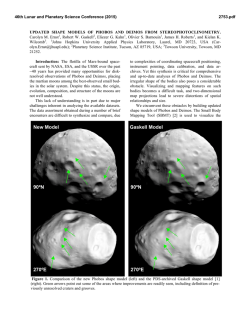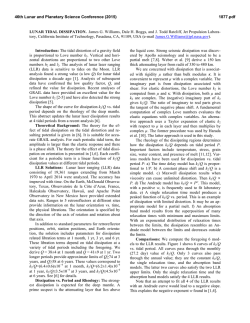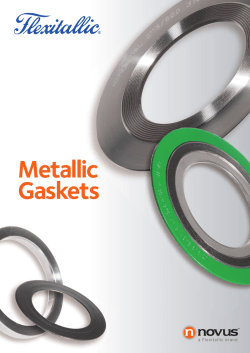
ACCRETION OF MID-SIZED ICE-RICH MOONS FROM EXPANSION
46th Lunar and Planetary Science Conference (2015) 2314.pdf ACCRETION OF MID-SIZED ICE-RICH MOONS FROM EXPANSION OF A PRIMORDIAL MASSIVE SATURNIAN RING. J. Salmon1 and R. M. Canup1, 1Southwest Research Institute, Planetary Science Directorate, 1050 Walnut Street - Suite 300, Boulder, CO, 80302, USA ([email protected]) Introduction: Saturn’s satellites display a diversity of compositions and masses that is challenging to explain. Massive Titan likely formed in Saturn’s primordial subnebula [1]. The small moons orbiting close to the rings, from Atlas to Janus, formed recently as ring material collisionally spread outward [2]. However the origin of the mid-sized moons exterior to Janus and interior to Titan is debated. A model for the origin of Saturn’s rings via tidal stripping from a primordial Titan-sized satellite implies that the rings were initially orders-of-magnitude more massive than today [3]. Ring models show that as an initially massive ring viscously spreads, its mass asymptotically approaches that of the current rings over 4.5 Gyr [4]. It is thus natural to consider whether the mid-sized moons could have originated from material spreading outward from a massive early ring. Initial estimates suggested that such a ring would spawn moons with masses and distances similar to those of Mimas, Enceladus and Tethys, assuming a tidal parameter for Saturn Q ~ 104 to 105 [3]. Subsequent simulations by [5] consider much stronger tidal dissipation with Q ~ 103, and in this case, the masses and positions of all of the mid-sized moons including Rhea and Dione could be explained as byproducts of the ring’s expansion [5]. While Q ~ 103 for Saturn has been proposed [6] it is controversial, because the same data show Mimas evolving inward, counter to expectations [7]. The code in [5] also did not explicitly treat interactions between growing satellites, including scattering and capture into mutual resonances, which can affect the resulting system architecture and stability. We here explore whether Mimas, Enceladus and Tethys (or their progenitors) could have been spawned from a massive ice-rich ring, assuming weak tidal dissipation in Saturn and using an N-body model to treat satellite growth [8]. Dione and Rhea would then have formed separately from the Saturn subnebula, as in [1]. Compositional constraints: Although the midsized moons show a diversity of densities, two groupings can be made based on the total mass of rock in each object (Table 1). The inner three moons (M, E & T) each contain 5 1019 kg in rock, while the outer two (D & R) each have ≥ 50 1019 kg in rock. The total rock mass in the inner three moons could have been supplied by impactors during the late heavy bombardment, while the rock content of Dione or Rhea would not have been substantially affected [9]. Enceladus is currently rock-rich, but it may have lost substantial ice if its current activity has been typical over its history. We here consider that the inner three moons were initially primarily ice, with their rock delivered subsequently by external bombardment. Whether this can account for the observed distribution of densities in M, E and T is an open and important question. Table 1. Properties of Saturn’s mid-sized inner satellites. Simulation: Our model [8] couples an analytic ring model to the N-body code SyMBA [10], and includes ring spreading (with a viscosity including the effects of the rings’ self-gravity), tidal accretion criteria, ringsatellite interactions at the strongest Lindblad resonances, and satellite tidal evolution. As the ring spreads beyond the Roche limit (aR 2.2RS, where Rs is Saturn’s current mean radius), mass and angular momentum are removed from the ring and added to the Nbody code as new small moonlets. We use [11] to compute the torque on satellite orbits due to Saturn tides, with a time delay equivalent to Q 104. We set Saturn’s radius to 1.3 to 1.5RS to represent its primordial state [12], and use conservation of its spin angular momentum to compute its corresponding rotation rate. Our initial ring masses are 0.5 to 3 10-5 Saturn masses (MS). Saturn’s current rings contain ~ 10-7MS. Results: Fig. 1 shows a sample simulation. For the runs here for few 107 yr, tidal expansion of the satellite orbits is minimal. Each satellite recoils from the ring due to direct ring torques until it reaches a distance ~ 1.6aR ~ 3.6RS, at which point its strongest resonances fall outside the ring. However the outer satellite typically evolves beyond this distance due to interactions with inner bodies (Fig. 2). When an outer satellites scatters an inner one toward the planet, the outer can gain angular momentum and increase its semi-major axis. Also if an outer satellite becomes trapped in a mean motion resonance with an inner moonlet whose strong resonances fall in the ring, resonant expansion of the inner moon drives the outer moon outward as well to distances beyond 3.6RS. Fig. 3 shows the distribution of satellites obtained in 12 simulations at different times. The number of final moons in each simulation was 3.5 1.4. The 46th Lunar and Planetary Science Conference (2015) spawned moon masses are broadly similar to those of Mimas, Enceladus and Tethys. Although tidal expansion has been unimportant in these simulations, ring torques and mutual satellite interactions have caused the outermost, largest moons to reach distances approaching that of Tethys. Further orbital expansion is expected for longer simulation times. Our future work will include the evolution of the position of synchronous orbit as the planet contracts and spins up [3], as well as the presence of Dione and Rhea. T=0 2314.pdf T=105 yrs T=106 yrs T=104 yrs T107 yrs 5 T=10 yrs T=107 yrs Figure 1. Snapshots of a sample simulation. As ring spreads beyond aR (dashed line), material accretes into new moonlets that can merge with each other and grow. Resonant torques, mutual scattering and capture in mean motion resonances lead to rapid orbital expansion. Figure 2. Evolution of the semi-major axis (SMA) of an outer body and inner moonlets. Initially, the object’s SMA expands due to disk torques. At 3105 yr, it captures an inner object into its 4:5 mean motion resonance. The inner object is pushed by the disk, and the outer body’s SMA expands due to the resonant configuration. Figure 3. Mass and semi-major axes of the satellites formed in our simulations at progressive times. By a few 107 years, the simulated moons have a broadly similar distribution to Mimas, Enceladus and Tethys. Green crosses are satellites from 8 of the 12 runs that have reached a simulation time of 3x107 years. References: [1] Canup, R. M. & Ward, W. R. (2006) Nature, 441, 834-839. [2] Charnoz, S. et al. (2010) Nature, 465, 752-754. [3] Canup (2010) Nature, 468, 943-946. [4] Salmon, J. et al. (2010) Icarus, 209, 771-785. [5] Charnoz, S. et al. (2011) Icarus, 216, 535-550. [6] Lainey et al. (2012), ApJ, 752:14. [7] Ogilvie, G. (2014) Ann Rev Astron Astrophys, 52, 171-210. [8] Salmon, J. & Canup, R. (2012) ApJ, 760:83. [9] Canup, R. (2013) LPSC XLIV, 1719. [10] Duncan, M. et al. (1998) AJ, 116, 2067-2077. [11] Mignard, F. (1981) Moon and Planets, 24, 189. [12] Fortney, J. et al. (2007) ApJ, 659, 1661-1672.
© Copyright 2026
